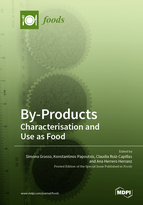By-Products: Characterisation and Use as Food
A special issue of Foods (ISSN 2304-8158). This special issue belongs to the section "Food Physics and (Bio)Chemistry".
Deadline for manuscript submissions: closed (20 June 2021) | Viewed by 57394
Special Issue Editors
Interests: food reformulation; functional foods; meat and dairy analogues; food waste valorisation; consumer attitudes and rapid sensory profiling techniques
Special Issues, Collections and Topics in MDPI journals
Interests: food science; antioxidants; postharvest physiology; fruit quality; plant physiology
Special Issues, Collections and Topics in MDPI journals
Interests: meat quality; food safety; animal production; food analysis; meat science; poultry; animal nutrition; food microbiology and safety; food science and technology; food preservation
Special Issues, Collections and Topics in MDPI journals
Interests: development of healthy meat products; vibrational spectroscopic techniques (raman and infrared spectroscopy); textural properties; biogenic amines; food safety; quality indices
Special Issues, Collections and Topics in MDPI journals
Special Issue Information
Dear Colleagues,
Each year, the agricultural industry produces high amounts of animal and plant by-products, which in many cases are not valorised, thus generating a major environmental problem. For this reason and also for economic motives, the interest in adding value to these by-products has recently increased. Many by-products can be transformed into edible ingredients, becoming natural sources of nutritionally enhancing compounds with positive health effects, such as polyphenols, proteins, fibres, lipids, etc. These agro-industrial by-products and co-products can be used as ingredients in food, upcycling them to produce different eco-friendly products such as baked goods, cereals, snacks, meat, fish, dairy products, etc. This Special Issue aims to collect recent advances in agro-industry by-products and co-products in relation to the use of by-products as food and their use as food-grade ingredients in the formulation of different food products. Specifically, this Special Issue focuses on the extraction, processing, and characterisation of by-products and associated technological, nutritional, and sensory quality. Articles on new approaches and novel technologies such as encapsulation to improve delivery of the extracted bioactive compounds into foods are welcome. The Editors are also interested in contributions on consumer attitudes towards the use of upcycled ingredients and circular economy initiatives in foods. The authors can collaborate original research papers, reviews, and short communications to expand knowledge on this topic and potential applications in future innovations.
Dr. Simona Grasso
Dr. Claudia Ruiz-Capillas
Dr. Konstantinos Papoutsis
Dr. Ana Herrero Herranz
Guest Editors
Manuscript Submission Information
Manuscripts should be submitted online at www.mdpi.com by registering and logging in to this website. Once you are registered, click here to go to the submission form. Manuscripts can be submitted until the deadline. All submissions that pass pre-check are peer-reviewed. Accepted papers will be published continuously in the journal (as soon as accepted) and will be listed together on the special issue website. Research articles, review articles as well as short communications are invited. For planned papers, a title and short abstract (about 100 words) can be sent to the Editorial Office for announcement on this website.
Submitted manuscripts should not have been published previously, nor be under consideration for publication elsewhere (except conference proceedings papers). All manuscripts are thoroughly refereed through a single-blind peer-review process. A guide for authors and other relevant information for submission of manuscripts is available on the Instructions for Authors page. Foods is an international peer-reviewed open access semimonthly journal published by MDPI.
Please visit the Instructions for Authors page before submitting a manuscript. The Article Processing Charge (APC) for publication in this open access journal is 2900 CHF (Swiss Francs). Submitted papers should be well formatted and use good English. Authors may use MDPI's English editing service prior to publication or during author revisions.
Keywords
- valorisation
- food by-products
- upcycled ingredients
- functional foods
- bioactive compounds
- non-conventional novel technologies
- circular economy
- consumer attitudes
- sensory quality







